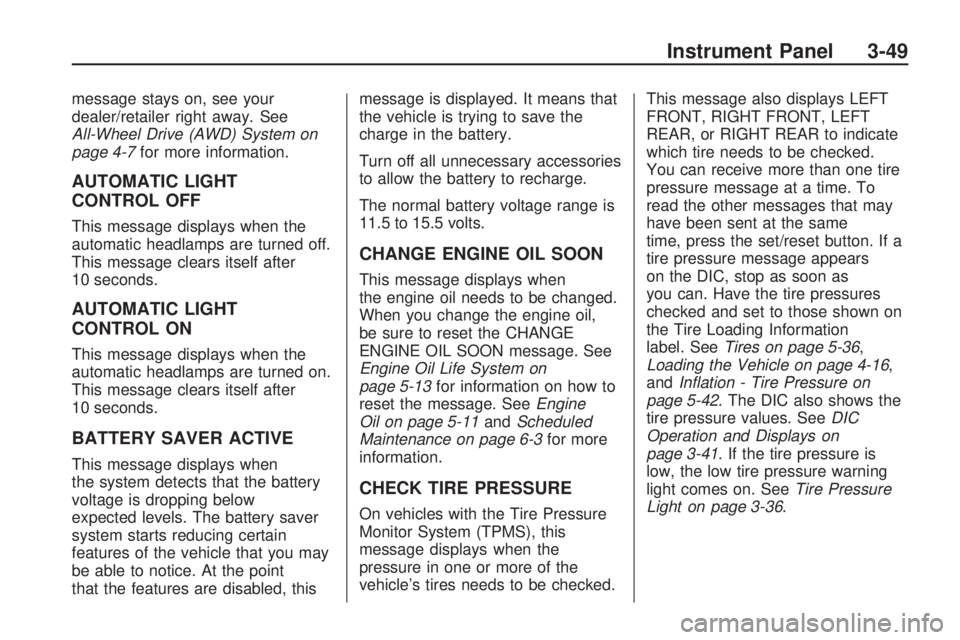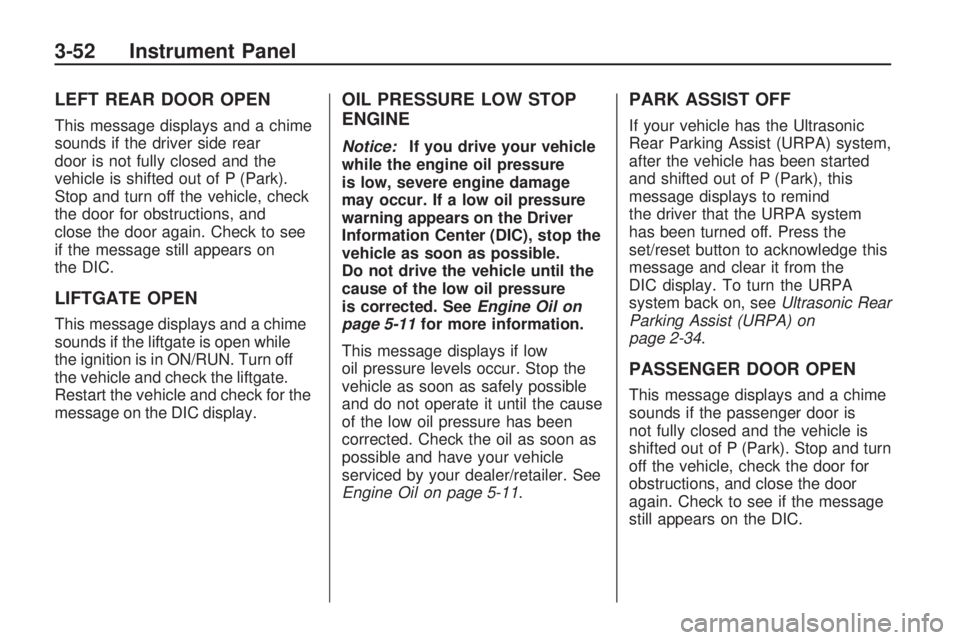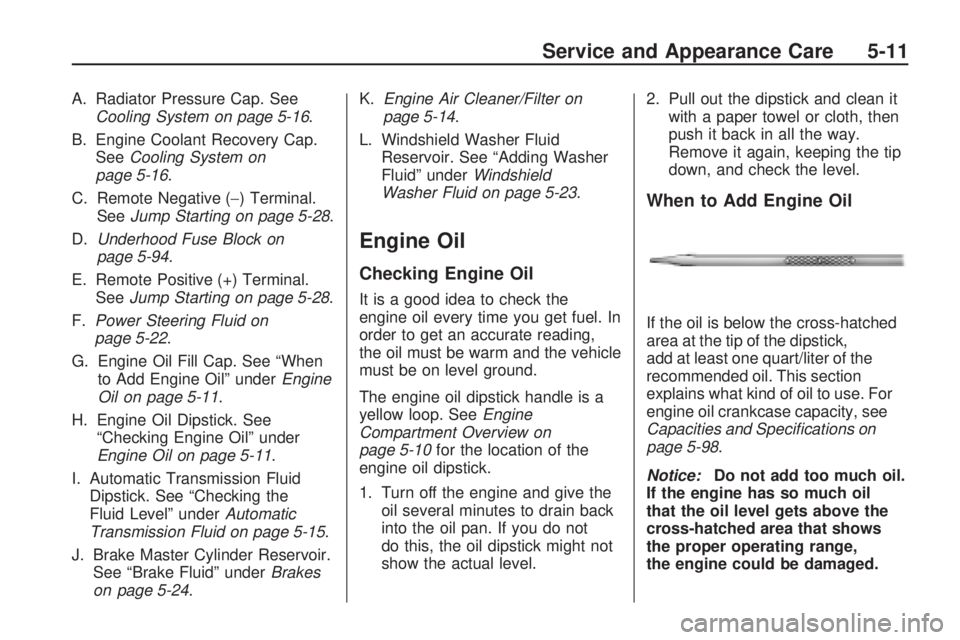oil level BUICK ENCLAVE 2009 Owner's Manual
[x] Cancel search | Manufacturer: BUICK, Model Year: 2009, Model line: ENCLAVE, Model: BUICK ENCLAVE 2009Pages: 412
Page 167 of 412

message stays on, see your
dealer/retailer right away. See
All-Wheel Drive (AWD) System on
page 4-7for more information.
AUTOMATIC LIGHT
CONTROL OFF
This message displays when the
automatic headlamps are turned off.
This message clears itself after
10 seconds.
AUTOMATIC LIGHT
CONTROL ON
This message displays when the
automatic headlamps are turned on.
This message clears itself after
10 seconds.
BATTERY SAVER ACTIVE
This message displays when
the system detects that the battery
voltage is dropping below
expected levels. The battery saver
system starts reducing certain
features of the vehicle that you may
be able to notice. At the point
that the features are disabled, thismessage is displayed. It means that
the vehicle is trying to save the
charge in the battery.
Turn off all unnecessary accessories
to allow the battery to recharge.
The normal battery voltage range is
11.5 to 15.5 volts.
CHANGE ENGINE OIL SOON
This message displays when
the engine oil needs to be changed.
When you change the engine oil,
be sure to reset the CHANGE
ENGINE OIL SOON message. See
Engine Oil Life System on
page 5-13for information on how to
reset the message. SeeEngine
Oil on page 5-11andScheduled
Maintenance on page 6-3for more
information.
CHECK TIRE PRESSURE
On vehicles with the Tire Pressure
Monitor System (TPMS), this
message displays when the
pressure in one or more of the
vehicle’s tires needs to be checked.This message also displays LEFT
FRONT, RIGHT FRONT, LEFT
REAR, or RIGHT REAR to indicate
which tire needs to be checked.
You can receive more than one tire
pressure message at a time. To
read the other messages that may
have been sent at the same
time, press the set/reset button. If a
tire pressure message appears
on the DIC, stop as soon as
you can. Have the tire pressures
checked and set to those shown on
the Tire Loading Information
label. SeeTires on page 5-36,
Loading the Vehicle on page 4-16,
andInflation - Tire Pressure on
page 5-42. The DIC also shows the
tire pressure values. SeeDIC
Operation and Displays on
page 3-41. If the tire pressure is
low, the low tire pressure warning
light comes on. SeeTire Pressure
Light on page 3-36.
Instrument Panel 3-49
Page 170 of 412

LEFT REAR DOOR OPEN
This message displays and a chime
sounds if the driver side rear
door is not fully closed and the
vehicle is shifted out of P (Park).
Stop and turn off the vehicle, check
the door for obstructions, and
close the door again. Check to see
if the message still appears on
the DIC.
LIFTGATE OPEN
This message displays and a chime
sounds if the liftgate is open while
the ignition is in ON/RUN. Turn off
the vehicle and check the liftgate.
Restart the vehicle and check for the
message on the DIC display.
OIL PRESSURE LOW STOP
ENGINE
Notice:If you drive your vehicle
while the engine oil pressure
is low, severe engine damage
may occur. If a low oil pressure
warning appears on the Driver
Information Center (DIC), stop the
vehicle as soon as possible.
Do not drive the vehicle until the
cause of the low oil pressure
is corrected. SeeEngine Oil on
page 5-11for more information.
This message displays if low
oil pressure levels occur. Stop the
vehicle as soon as safely possible
and do not operate it until the cause
of the low oil pressure has been
corrected. Check the oil as soon as
possible and have your vehicle
serviced by your dealer/retailer. See
Engine Oil on page 5-11.
PARK ASSIST OFF
If your vehicle has the Ultrasonic
Rear Parking Assist (URPA) system,
after the vehicle has been started
and shifted out of P (Park), this
message displays to remind
the driver that the URPA system
has been turned off. Press the
set/reset button to acknowledge this
message and clear it from the
DIC display. To turn the URPA
system back on, seeUltrasonic Rear
Parking Assist (URPA) on
page 2-34.
PASSENGER DOOR OPEN
This message displays and a chime
sounds if the passenger door is
not fully closed and the vehicle is
shifted out of P (Park). Stop and turn
off the vehicle, check the door for
obstructions, and close the door
again. Check to see if the message
still appears on the DIC.
3-52 Instrument Panel
Page 246 of 412

Hydroplaning
Hydroplaning is dangerous. Water
can build up under your vehicle’s
tires so they actually ride on
the water. This can happen if the
road is wet enough and you
are going fast enough. When your
vehicle is hydroplaning, it has little or
no contact with the road.
There is no hard and fast rule about
hydroplaning. The best advice is
to slow down when the road is wet.
Other Rainy Weather Tips
Besides slowing down, other wet
weather driving tips include:
Allow extra following distance.
Pass with caution.
Keep windshield wiping
equipment in good shape.
Keep the windshield washer �uid
reservoir �lled.
Have good tires with proper tread
depth. SeeTires on page 5-36.
Turn off cruise control.
Before Leaving on a
Long Trip
To prepare your vehicle for a long
trip, consider having it serviced
by your dealer/retailer before
departing.
Things to check on your own
include:
Windshield Washer Fluid:
Reservoir full? Windows
clean — inside and outside?
Wiper Blades:In good shape?
Fuel, Engine Oil, Other Fluids:All
levels checked?
Lamps:Do they all work and are
lenses clean?
Tires:Are treads good? Are tires
in�ated to recommended
pressure?
Weather and Maps:Safe to
travel? Have up-to-date maps?
Highway Hypnosis
Always be alert and pay attention
to your surroundings while driving.
If you become tired or sleepy, �nd a
safe place to park your vehicle
and rest.
Other driving tips include:
Keep the vehicle well ventilated.
Keep interior temperature cool.
Keep your eyes moving — scan
the road ahead and to the sides.
Check the rearview mirror and
vehicle instruments often.
4-12 Driving Your Vehicle
Page 279 of 412

A. Radiator Pressure Cap. See
Cooling System on page 5-16.
B. Engine Coolant Recovery Cap.
SeeCooling System on
page 5-16.
C. Remote Negative (−) Terminal.
SeeJump Starting on page 5-28.
D.Underhood Fuse Block on
page 5-94.
E. Remote Positive (+) Terminal.
SeeJump Starting on page 5-28.
F.Power Steering Fluid on
page 5-22.
G. Engine Oil Fill Cap. See “When
to Add Engine Oil” underEngine
Oil on page 5-11.
H. Engine Oil Dipstick. See
“Checking Engine Oil” under
Engine Oil on page 5-11.
I. Automatic Transmission Fluid
Dipstick. See “Checking the
Fluid Level” underAutomatic
Transmission Fluid on page 5-15.
J. Brake Master Cylinder Reservoir.
See “Brake Fluid” underBrakes
on page 5-24.K.Engine Air Cleaner/Filter on
page 5-14.
L. Windshield Washer Fluid
Reservoir. See “Adding Washer
Fluid” underWindshield
Washer Fluid on page 5-23.
Engine Oil
Checking Engine Oil
It is a good idea to check the
engine oil every time you get fuel. In
order to get an accurate reading,
the oil must be warm and the vehicle
must be on level ground.
The engine oil dipstick handle is a
yellow loop. SeeEngine
Compartment Overview on
page 5-10for the location of the
engine oil dipstick.
1. Turn off the engine and give the
oil several minutes to drain back
into the oil pan. If you do not
do this, the oil dipstick might not
show the actual level.2. Pull out the dipstick and clean it
with a paper towel or cloth, then
push it back in all the way.
Remove it again, keeping the tip
down, and check the level.
When to Add Engine Oil
If the oil is below the cross-hatched
area at the tip of the dipstick,
add at least one quart/liter of the
recommended oil. This section
explains what kind of oil to use. For
engine oil crankcase capacity, see
Capacities and Specifications on
page 5-98.
Notice:Do not add too much oil.
If the engine has so much oil
that the oil level gets above the
cross-hatched area that shows
the proper operating range,
the engine could be damaged.
Service and Appearance Care 5-11
Page 280 of 412

SeeEngine Compartment Overview
on page 5-10for the location of
the engine oil �ll cap.
Add enough oil to put the level
somewhere in the proper operating
range in the cross-hatched area.
Push the dipstick all the way back in
when you are through.
What Kind of Engine Oil to Use
Look for three things:
GM6094M
Use only an oil that meets GM
Standard GM6094M.
SAE 5W-30
SAE 5W-30 is best for the
vehicle. These numbers on an oil
container show its viscosity, or
thickness. Do not use other
viscosity oils such as
SAE 20W-50.
American Petroleum Institute
(API) starburst symbol
Oils meeting these requirements
should have the starburst
symbol on the container. This
symbol indicates that the oil has
been certi�ed by the American
Petroleum Institute (API).
5-12 Service and Appearance Care
Page 281 of 412

Notice:Use only engine oil
identi�ed as meeting GM
Standard GM6094M and showing
the American Petroleum
Institute Certi�ed For Gasoline
Engines starburst symbol. Failure
to use the recommended oil
can result in engine damage not
covered by the vehicle warranty.
Cold Temperature Operation
If you are in an area of extreme
cold, where the temperature falls
below−20°F (−29°C), use either an
SAE 5W-30 synthetic oil or an
SAE 0W-30 engine oil. Both provide
easier cold starting for the engine at
extremely low temperatures. Always
use an oil that meets the required
speci�cation, GM6094M. See “What
Kind of Engine Oil to Use” for more
information.
Engine Oil Additives / Engine
Oil Flushes
Do not add anything to the oil. The
recommended oils with the starburst
symbol that meet GM Standard
GM6094M are all you need for good
performance and engine protection.
Engine oil system �ushes are not
recommended and could cause
engine damage not covered by the
vehicle warranty.
Engine Oil Life System
When to Change Engine Oil
This vehicle has a computer system
that lets you know when to change
the engine oil and �lter. This is based
on engine revolutions and engine
temperature, and not on mileage.
Based on driving conditions, the
mileage at which an oil change will
be indicated can vary considerably.
For the oil life system to work
properly, you must reset the system
every time the oil is changed.When the system has calculated
that oil life has been diminished, it
will indicate that an oil change
is necessary. A CHANGE ENGINE
OIL SOON message will come
on. Change the oil as soon
as possible within the next 600 miles
(1 000 km). It is possible that, if
you are driving under the best
conditions, the oil life system might
not indicate that an oil change is
necessary for over a year. However,
the engine oil and �lter must be
changed at least once a year and at
this time the system must be
reset. Your dealer/retailer has
trained service people who will
perform this work using genuine
parts and reset the system. It is also
important to check the oil regularly
and keep it at the proper level.
If the system is ever reset
accidentally, you must change the
oil at 3,000 miles (5 000 km)
since the last oil change. Remember
to reset the oil life system whenever
the oil is changed.
Service and Appearance Care 5-13
Page 286 of 412

Checking Coolant
The vehicle must be on a level
surface when checking the coolant
level.
Check to see if coolant is visible in
the coolant recovery tank. If the
coolant inside the coolant recovery
tank is boiling, do not do anything
else until it cools down. If coolant is
visible but the coolant level is not at
or above the FULL COLD mark, add
a 50/50 mixture of clean, drinkable
water and DEX-COOL coolant at the
coolant recovery tank, but be sure
the cooling system is cool before this
is done. SeeEngine Coolant on
page 5-17for more information.
The coolant recovery tank cap has
this symbol on it.When the engine is cold, the
coolant level should be at or above
the FULL COLD line marked on
the recovery tank.
When the engine is hot, the level
could be higher than the FULL
COLD line. If the coolant is below
the FULL COLD line when the
engine is hot, there could be a leak
in the cooling system.
If the coolant is low, add the coolant
or take the vehicle to a
dealer/retailer for service.
How to Add Coolant to the
Recovery Tank
{CAUTION
You can be burned if you spill
coolant on hot engine parts.
Coolant contains ethylene glycol
and it will burn if the engine parts
are hot enough. Do not spill
coolant on a hot engine.Notice:This vehicle has a
speci�c coolant �ll procedure.
Failure to follow this procedure
could cause the engine to
overheat and be severely
damaged.
If coolant is needed, add the proper
DEX-COOL
®coolant mixture at
the coolant recovery tank.
How to Add Coolant to the
Radiator
{CAUTION
An electric engine cooling fan
under the hood can start up even
when the engine is not running
and can cause injury. Keep
hands, clothing, and tools away
from any underhood electric fan.
5-18 Service and Appearance Care
Page 291 of 412

When to Check Power
Steering Fluid
It is not necessary to regularly
check power steering �uid unless
you suspect there is a leak in
the system or you hear an unusual
noise. A �uid loss in this system
could indicate a problem. Have the
system inspected and repaired.
How to Check Power Steering
Fluid
To check the power steering �uid:
1. Turn the key off and let the
engine compartment cool down.
2. Remove engine oil �ll cap.
3. Slide engine cover rearward and
lift to remove.
4. Wipe the cap and the top of the
reservoir clean.
5. Unscrew the cap and wipe the
dipstick with a clean rag.6. Replace the cap and completely
tighten it.
7. Remove the cap again and look
at the �uid level on the dipstick.
The �uid level should be somewhere
between MAX and MIN line on the
dipstick in room temperature. If the
�uid is on or below MIN line, you
should add �uid close to MAX Line.
What to Use
To determine what kind of �uid to
use, seeRecommended Fluids and
Lubricants on page 6-12. Always
use the proper �uid.
Notice:Use of the incorrect �uid
may damage the vehicle and
the damages may not be covered
by the vehicle’s warranty.
Always use the correct �uid
listed inRecommended Fluids
and Lubricants on page 6-12.
Windshield Washer Fluid
What to Use
When adding windshield washer
�uid, be sure to read the
manufacturer’s instructions before
use. If the vehicle will be operating in
an area where the temperature may
fall below freezing, use a �uid that
has sufficient protection against
freezing.
Service and Appearance Care 5-23
Page 293 of 412

A �uid leak in the brake hydraulic
system can also cause a low �uid
level. Have the brake hydraulic
system �xed, since a leak means
that sooner or later the brakes will
not work well.
Do not top off the brake �uid. Adding
�uid does not correct a leak. If �uid is
added when the linings are worn,
there will be too much �uid when new
brake linings are installed. Add or
remove brake �uid, as necessary,
only when work is done on the brake
hydraulic system.
{CAUTION
If too much brake �uid is added, it
can spill on the engine and burn, if
the engine is hot enough. You or
others could be burned, and the
vehicle could be damaged. Add
brake �uid only when work is done
on the brake hydraulic system.When the brake �uid falls to a low
level, the brake warning light comes
on. SeeBrake System Warning
Light on page 3-33.
What to Add
Use only new DOT-3 brake �uid
from a sealed container. See
Recommended Fluids and
Lubricants on page 6-12.
Always clean the brake �uid
reservoir cap and the area around
the cap before removing it. This
helps keep dirt from entering
the reservoir.{CAUTION
With the wrong kind of �uid in the
brake hydraulic system, the
brakes might not work well. This
could cause a crash. Always use
the proper brake �uid.Notice:
Using the wrong �uid
can badly damage brake
hydraulic system parts. For
example, just a few drops
of mineral-based oil, such
as engine oil, in the brake
hydraulic system can damage
brake hydraulic system
parts so badly that they will
have to be replaced. Do not let
someone put in the wrong
kind of �uid.
If brake �uid is spilled on the
vehicle’s painted surfaces, the
paint �nish can be damaged. Be
careful not to spill brake �uid
on the vehicle. If you do, wash it
off immediately. SeeWashing
Your Vehicle on page 5-86.
Service and Appearance Care 5-25
Page 366 of 412

Capacities and Speci�cations
The following approximate capacities are given in English and metric conversions. SeeRecommended Fluids and
Lubricants on page 6-12 for more information.
Application Capacities
English Metric
Air Conditioning Refrigerant R134a For the air conditioning system refrigerant charge
amount, see the refrigerant caution label located
under the hood. See your dealer/retailer for more information.
Cooling System 11.4 qt 10.8 L
Engine Oil with Filter 5.5 qt 5.2 L
Fuel Tank 22.0 gal 83.3 L
Transmission Fluid* 5.3 qt 5.0 L
Wheel Nut Torque 140 lb ft 190 Y
*Transmission �uid capacity is approximate. See Automatic Transmission Fluid on page 5-15for information on
checking �uid level.
All capacities are approximate. When adding, be sure to �ll to the approximate level, as recommended in this
manual. Recheck �uid level after �lling.
Engine Speci�cations
Engine VIN CodeTransmission Spark Plug Gap
3.6L V6 Engine DAutomatic 0.043 in (1.10 mm)
5-98 Service and Appearance Care